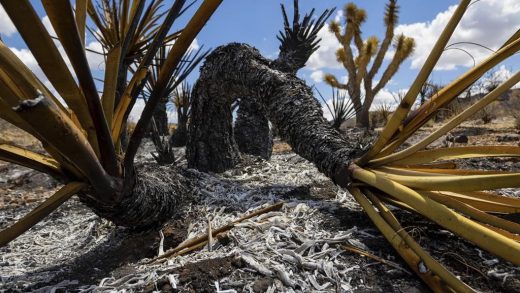Well that’s a trip: ‘Psychedelics: The Experiential Exhibition’ explores our long relationship with hallucinogens
:format(webp)/https://www.thestar.com/content/dam/thestar/entertainment/visualarts/2022/09/30/well-thats-a-trip-psychedelics-the-experiential-exhibition-explores-our-long-relationship-with-hallucinogens/a_psychedelic.jpg)
One could argue that there is no more “immersive” an art trip than a proper psychedelic experience.
Before we have that argument, however, please direct your attention to “Psychedelics: The Experiential Exhibition,” yet another art trip in the Immersive art experience vein opening in Toronto Friday, Sept. 30, amidst the hitherto underexploited warrens of Lithuanian House, mere steps away from the intersection of Bloor and Dundas Streets West.
Whether you’re into psychedelics or not or just casually orbiting somewhere in between, a stroll through this 12,000-square-foot multimedia study of humanity’s long relationship with hallucinogens should leave you with a better understanding of why so many people have chosen to indulge — immerse themselves, if you will — in the otherworldly potential of mind-altering substances since pretty much the dawn of recorded time.
And, yes, its labyrinthine mushroom forests, blacklit peyote-vision grottos and dazzling audiovisual freakery will almost certainly trip you out, albeit whilst simultaneously offering you a thoughtful tour through “the past, present and future of psychedelics,” from ancient Greek ergot beverages and ayahuasca to LSD, MDMA and 5-MeO-DMT.
Curator/creator James Drayton, who became fascinated with the potential of “the intersection of art and technology and experience” while working on Lighthouse Immersive’s magic-themed Illusionarium exhibit during COVID times, is confident there’s enough interest in the subject out there — and in “immersive” attractions in general — to have taken out a five-month lease on Lithuanian House, with an option to renew early next year should “Psychedelics” “catch fire.” At present, he’s corralled around 25 artists from around the globe to participate, with the hope that others might also turn on and tune in down the road as the project evolves.
“I hope I’m not in over my head,” laughs Drayton, winding his way through the pre-show setup chaos at the venue just before the exhibition was to open its doors for an invite-only preview. “I pitched this to a lot of people, and a lot of people just looked at me like I was crazy, especially partners and investors and those sorts of things.
“Where there were artists who sort of resonated and I thought they would fit, I would reach out to them and a lot of people said ‘no.’ But some people were, like, ‘I love it. I’m in.’ They understood the spirit of what we were trying to do and jumped in. Like Clandestinos and GMUNK. I wrote GMUNK this 5000-word email and he wrote me back with a one-sentence response: ‘You had me at psychedelics.’ So he was in. It was, like, whoever understood the spirit of it, you’d run with. And that’s who’s in it.”
“Psychedelics: The Experiential Exhibition” arrives at a moment in time when the concept of “psychedelics therapy” — using heretofore forbidden substances such as psilocybin and ketamine to treat such afflictions as depression and post-traumatic stress disorder — are being more and more openly discussed. And that’s the thread uniting the many disparate works on display at Lithuanian House, from Casey Watson’s “magic-mushroom infinity room” to a replica of one of Ken Kesey’s acid-test venues to GMUNK’s enormous ayahuasca-shaman “Totem” AV installation: for thousands of years human beings have been drawn to psychedelics, so rather than demonizing them and banning them might it be better to ask why so many seem to derive benefits from them?
“That’s the timeliness of all this, right? When I was thinking about it and evaluating it, I watched webinars and stuff and what really struck me was the testimony of a U.S. veteran who’d been suffering terrible PTSD after serving and had tried all the therapies and all the medications and nothing had helped until somebody suggested he try psychedelics therapy,” says Drayton. “That’s why I’m bullish, because of the aspect that these things are now being used responsibly, often legally, in safe settings with guides and really impacting people’s lives in a positive way.
“There’s a message to tell, and a new story to tell. So the opportunity to create a show that not only is entertaining and visually amazing but that has a purpose and a cultural relevance was what got me really excited to actively pursue this topic.
“Some of this is psychedelic art, but I’ve taken a different approach where we’re telling the story of psychedelics supported visually by art that is somehow connected to psychedelics.”
Don’t worry. “Edutainment” aside, the exhibition space is also just a fun place to hang out, and many of the artists involved have clearly approached the subject in that spirit.
Local street artist Emily May Rose, for instance, welcomed the chance to catapult her trademark Toronto raccoons to the other side in a whimsical stairway mural that sees them frolicking with greater abandon after ingesting psilocybin mushrooms as one ascends until, as she puts it, “all hell breaks loose” at the top.
“On the ‘fun’ side of it, I was on board right away. Psychedelics? Those are fun themes to work with visually. When I came in I thought I could look at, like, Grateful Dead art and “Yellow Submarine” and stuff like that — stuff that I love — for inspiration so that whole thing seemed ‘on brand’ for me. But it’s not like an Instagram gallery. It’s not just a space that was made to look cool in photos. There’s the whole educational side of the exhibition.”
Minneapolis-raised multimedia visionary GMUNK — A.K.A. Bradley Munkowitz — aimed for a similar balance in creating his monstrous Totem installation. Yes, the massive video- and laser-streaked dangling sculpture is a truly mind-blowing thing to behold, but its nine-minute program also guides you through the different stages of an ayahuasca ceremony to highlight the transformative, spiritual nature of a deep psychedelic experience.
“We wanted to create a spiritual guide in the form of a sculpture,” says GMUNK. “That’s what we wanted to convey here, not just the visual aspect of it but the spiritual aspect of it. There’s an emotional connection. It talks to you. It guides you through the ceremony.
“I’m a huge, huge, huge proponent of psychedelics, but I’m into the self-discovery aspect of them. I just want people to be moved.”
For tickets and more information, go to psychedelicsshow.com
JOIN THE CONVERSATION


